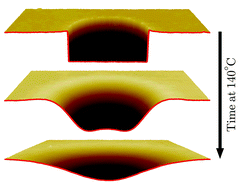Capillary levelling of a cylindrical hole in a viscous film
Abstract
The capillary levelling of cylindrical holes in viscous polystyrene films was studied using atomic force microscopy as well as quantitative analytical scaling arguments based on thin film theory and self-similarity. The relaxation of the holes was shown to consist of two different time regimes: an early regime where opposing sides of the hole do not interact, and a late regime where the hole is filling up. For the latter, the self-similar asymptotic profile was derived analytically and shown to be in excellent agreement with experimental data. Finally, a binary system of two holes in close proximity was investigated where the individual holes fill up at early times and coalesce at longer times.


 Please wait while we load your content...
Please wait while we load your content...